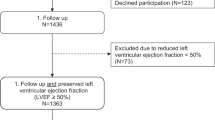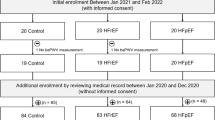Abstract
Aims
Diabetes is associated with higher arterial stiffness—an early marker of cardiovascular disease. The coupling between arterial stiffness and myocardial function is still unresolved. We investigate associations between arterial stiffness and early myocardial impairment assessed with advanced echocardiography.
Methods
In 305 type 1 diabetes (T1D) patients without known heart disease and with normal left ventricular ejection fraction (LVEF) (biplane LVEF > 45%), we measured arterial stiffness as pulse wave velocity (PWV) and performed conventional and speckle-tracking echocardiography assessing global longitudinal strain (GLS) as a measure of systolic myocardial function. Associations between PWV and myocardial function were reported as standardized beta values from adjusted regression models including age, sex, mean arterial pressure, body mass index, HbA1c, diabetes duration, estimated glomerular filtration rate, degree of albuminuria, total cholesterol, heart rate and smoking.
Results
Patients were 54 (12) years [mean (SD)], 152 (50%) females, diabetes duration 31 (16) years, HbA1c 65 (12) mmol/mol, LVEF 58 (5) %, GLS −18.2 (2.6) % and PWV 10.2 (3.4) m/s. There was no association between PWV and LVEF (p = 0.93). Conversely, there was a highly significant association between PWV and GLS in crude and multivariable models (standardized β-coefficient 0.25, p < 0.001 and 0.16, p = 0.036, respectively). Also, diastolic function measured as E/e′ was highly associated with PWV in crude and multivariable models (standardized β-coefficient 0.43, p < 0.001 and 0.17, p = 0.016, respectively).
Conclusions
In T1D patients with normal LVEF and without known heart disease, higher arterial stiffness is independently associated with early systolic and diastolic myocardial impairment detectable by advanced echocardiography. Although unable to demonstrate causality, we display a relationship between diabetic angiopathy and diabetic cardiomyopathy (H-3-2009-139 and PROFIL-H-B-2009-056).

Similar content being viewed by others
Abbreviations
- CVD:
-
Cardiovascular disease
- GFR:
-
Glomerular filtration rate
- GLS:
-
Global strain
- IQR:
-
Interquartile range
- PWV:
-
Pulse wave velocity
- RAAS:
-
Renin–angiotensin–aldosterone system
- TDI:
-
Tissue Doppler imaging
- T1D:
-
Type 1 diabetes
- UAER:
-
Urinary albumin excretion rate
References
Matteucci E, Giampietro O (2014) Epidemiology of cardiovascular disease in patients with type 1 diabetes: European perspective. Exp Clin Endocrinol Diabetes 122:208–214
Morrish NJ, Wang SL, Stevens LK, Fuller JH, Keen H (2001) Mortality and causes of death in the WHO multinational study of vascular disease in diabetes. Diabetologia 44(Suppl 2):S14–S21
Orchard TJ, Costacou T, Kretowski A, Nesto RW (2006) Type 1 diabetes and coronary artery disease. Diabetes Care 29:2528–2538
Haffner SM, Lehto S, Ronnemaa T, Pyorala K, Laakso M (1998) Mortality from coronary heart disease in subjects with type 2 diabetes and in nondiabetic subjects with and without prior myocardial infarction. N Engl J Med 339:229–234
Black JA, Sharp SJ, Wareham NJ et al (2014) Does early intensive multifactorial therapy reduce modelled cardiovascular risk in individuals with screen-detected diabetes? Results from the ADDITION-Europe cluster randomized trial. Diabetes Med 31:647–656
Gaede P, Lund-Andersen H, Parving HH, Pedersen O (2008) Effect of a multifactorial intervention on mortality in type 2 diabetes. N Engl J Med 358:580–591
Aso Y, Inukai T, Tayama K, Takemura Y (2000) Serum concentrations of advanced glycation endproducts are associated with the development of atherosclerosis as well as diabetic microangiopathy in patients with type 2 diabetes. Acta Diabetol 37:87–92
Forbes JM, Cooper ME (2013) Mechanisms of diabetic complications. Physiol Rev 93:137–188
Llaurado G, Ceperuelo-Mallafre V, Vilardell C et al (2014) Advanced glycation end products are associated with arterial stiffness in type 1 diabetes. J Endocrinol 221:405–413
Persson M, Ostling G, Smith G et al (2014) Soluble urokinase plasminogen activator receptor: a risk factor for carotid plaque, stroke, and coronary artery disease. Stroke 45:18–23
Boudina S, Abel ED (2007) Diabetic cardiomyopathy revisited. Circulation 115:3213–3223
Hammes HP (2003) Pathophysiological mechanisms of diabetic angiopathy. J Diabetes Complicat 17:16–19
Kals J, Kampus P, Kals M et al (2008) Inflammation and oxidative stress are associated differently with endothelial function and arterial stiffness in healthy subjects and in patients with atherosclerosis. Scand J Clin Lab Invest 68:594–601
Mitchell GF (2008) Effects of central arterial aging on the structure and function of the peripheral vasculature: implications for end-organ damage. J Appl Physiol 105:1652–1660
Laurent S, Cockcroft J, Van BL et al (2006) Expert consensus document on arterial stiffness: methodological issues and clinical applications. Eur Heart J 27:2588–2605
Laurent S, Boutouyrie P, Asmar R et al (2001) Aortic stiffness is an independent predictor of all-cause and cardiovascular mortality in hypertensive patients. Hypertension 37:1236–1241
Trika CO, Zakopoulos N, Toumanidis ST, Stamatelopoulos SF, Moulopoulos SD (2004) Pulse pressure and left ventricular diastolic dysfunction in hypertensive patients. Cardiology 102:108–114
Vlachopoulos C, Aznaouridis K, Stefanadis C (2010) Prediction of cardiovascular events and all-cause mortality with arterial stiffness: a systematic review and meta-analysis. J Am Coll Cardiol 55:1318–1327
Willum-Hansen T, Staessen JA, Torp-Pedersen C et al (2006) Prognostic value of aortic pulse wave velocity as index of arterial stiffness in the general population. Circulation 113:664–670
Chan YH, Kuo CT, Wu LS et al (2016) combined global longitudinal strain and intraventricular mechanical dyssynchrony predicts long-term outcome in patients with systolic heart failure. Circ J 80:177–185
Krishnasamy R, Isbel NM, Hawley CM et al (2015) Left ventricular global longitudinal strain (GLS) is a superior predictor of all-cause and cardiovascular mortality when compared to ejection fraction in advanced chronic kidney disease. PLoS ONE 10:e0127044
Jensen MT, Sogaard P, Andersen HU et al (2016) Early myocardial impairment in type 1 diabetes patients without known heart disease assessed with tissue Doppler echocardiography: the Thousand & 1 study. Diabetes Vasc Dis Res 13:260–267
Gorcsan J III, Tanaka H (2011) Echocardiographic assessment of myocardial strain. J Am Coll Cardiol 58:1401–1413
Jensen MT, Sogaard P, Andersen HU et al (2014) Prevalence of systolic and diastolic dysfunction in patients with type 1 diabetes without known heart disease: the Thousand & 1 Study. Diabetologia 57:672–680
Jensen MT, Sogaard P, Andersen HU et al (2015) Global longitudinal strain is not impaired in type 1 diabetes patients without albuminuria: the Thousand & 1 Study. JACC Cardiovasc Imaging 8:400–410
Theilade S, Rossing P, Eugen-Olsen J, Jensen JS, Jensen MT (2016) suPAR level is associated with myocardial impairment assessed with advanced echocardiography in patients with type 1 diabetes with normal ejection fraction and without known heart disease or end-stage renal disease. Eur J Endocrinol 174:745–753
Lang RM, Bierig M, Devereux RB et al (2005) Recommendations for chamber quantification: a report from the American Society of Echocardiography’s Guidelines and Standards Committee and the Chamber Quantification Writing Group, developed in conjunction with the European Association of Echocardiography, a branch of the European Society of Cardiology. J Am Soc Echocardiogr 18:1440–1463
Lee DS, Gona P, Vasan RS et al (2009) Relation of disease pathogenesis and risk factors to heart failure with preserved or reduced ejection fraction: insights from the Framingham heart study of the national heart, lung, and blood institute. Circulation 119:3070–3077
Solomon SD, Anavekar N, Skali H et al (2005) Influence of ejection fraction on cardiovascular outcomes in a broad spectrum of heart failure patients. Circulation 112:3738–3744
Levey AS, Coresh J, Greene T et al (2006) Using standardized serum creatinine values in the modification of diet in renal disease study equation for estimating glomerular filtration rate. Ann Intern Med 145:247–254
Nagueh SF, Appleton CP, Gillebert TC et al (2009) Recommendations for the evaluation of left ventricular diastolic function by echocardiography. Eur J Echocardiogr 10:165–193
Kasner M, Westermann D, Steendijk P et al (2007) Utility of Doppler echocardiography and tissue Doppler imaging in the estimation of diastolic function in heart failure with normal ejection fraction: a comparative Doppler-conductance catheterization study. Circulation 116:637–647
Van Bortel LM, Laurent S, Boutouyrie P et al (2012) Expert consensus document on the measurement of aortic stiffness in daily practice using carotid-femoral pulse wave velocity. J Hypertens 30:445–448
Software Operator’s Guide—Atcor Medical Manual. 2008
Theilade S, Lajer M, Persson F, Joergensen C, Rossing P (2013) Arterial stiffness is associated with cardiovascular, renal, retinal, and autonomic disease in type 1 diabetes. Diabetes Care 36:715–721
Bell V, McCabe EL, Larson MG et al (2017) Relations between aortic stiffness and left ventricular mechanical function in the community. J Am Heart Assoc 6:e004903
Cruickshank K, Riste L, Anderson SG, Wright JS, Dunn G, Gosling RG (2002) Aortic pulse-wave velocity and its relationship to mortality in diabetes and glucose intolerance: an integrated index of vascular function? Circulation 106:2085–2090
Schram MT, Henry RM, van Dijk RA et al (2004) Increased central artery stiffness in impaired glucose metabolism and type 2 diabetes: the Hoorn Study. Hypertension 43:176–181
Fang ZY, Prins JB, Marwick TH (2004) Diabetic cardiomyopathy: evidence, mechanisms, and therapeutic implications. Endocr Rev 25:543–567
Miki T, Yuda S, Kouzu H, Miura T (2013) Diabetic cardiomyopathy: pathophysiology and clinical features. Heart Fail Rev 18:149–166
Zhang X, Chen C (2012) A new insight of mechanisms, diagnosis and treatment of diabetic cardiomyopathy. Endocrine 41:398–409
Mihm MJ, Seifert JL, Coyle CM, Bauer JA (2001) Diabetes related cardiomyopathy time dependent echocardiographic evaluation in an experimental rat model. Life Sci 69:527–542
Ernande L, Bergerot C, Rietzschel ER et al (2011) Diastolic dysfunction in patients with type 2 diabetes mellitus: is it really the first marker of diabetic cardiomyopathy? J Am Soc Echocardiogr 24(1268–1275):e1
Ibsen H, Olsen MH, Wachtell K, Borch-Johnsen K, Lindholm LH, Mogensen CE (2008) Reduction in albuminuria translates to reduction in cardiovascular events in hypertensive patients with left ventricular hypertrophy and diabetes. J Nephrol 21:566–569
de ZD, Remuzzi G, Parving HH et al. Albuminuria, a therapeutic target for cardiovascular protection in type 2 diabetic patients with nephropathy. Circulation 2004;110:921-927
Diez J, Querejeta R, Lopez B, Gonzalez A, Larman M, Martinez Ubago JL (2002) Losartan-dependent regression of myocardial fibrosis is associated with reduction of left ventricular chamber stiffness in hypertensive patients. Circulation 105:2512–2517
Mitsunami K, Inoue S, Maeda K et al (1998) Three-month effects of candesartan cilexetil, an angiotensin II type 1 (AT1) receptor antagonist, on left ventricular mass and hemodynamics in patients with essential hypertension. Cardiovasc Drugs Ther 12:469–474
Trost SU, Belke DD, Bluhm WF, Meyer M, Swanson E, Dillmann WH (2002) Overexpression of the sarcoplasmic reticulum Ca(2+)-ATPase improves myocardial contractility in diabetic cardiomyopathy. Diabetes 51:1166–1171
Rosenlund S, Theilade S, Hansen TW, Andersen S, Rossing P (2014) Treatment with continuous subcutaneous insulin infusion is associated with lower arterial stiffness. Acta Diabetol 51:955–962
Bakris GL, Molitch M (2014) Microalbuminuria as a risk predictor in diabetes: the continuing saga. Diabetes Care 37:867–875
Acknowledgements
The Thousand & 1 study was supported by The European Foundation for the Study of Diabetes/Pfizer European Programme 2010 for Research into Cardiovascular Risk Reduction in Patients with Diabetes; and The Danish Heart Foundation (#: 12-04-R90-A3840-22725).
Author information
Authors and Affiliations
Contributions
ST and MTJ researched the data, wrote the manuscript, contributed to the discussion and edited the manuscript. JSJ and PR contributed to the discussion and reviewed the manuscript.
Corresponding author
Ethics declarations
Conflict of interest
The authors have no conflict of interests.
Statement of human and animal rights
All procedures followed were in accordance with the ethical standards of the responsible committee on human experimentation (institutional and national) and with the Helsinki Declaration of 1975, as revised in 2008 (5).
Statement of informed consent
Informed consent was obtained from all patients for being included in the study.
Additional information
Managed by Massimo Federici.
Rights and permissions
About this article
Cite this article
Theilade, S., Rossing, P., Jensen, J.S. et al. Arterial-ventricular coupling in type 1 diabetes: arterial stiffness is associated with impaired global longitudinal strain in type 1 diabetes patients—the Thousand & 1 Study. Acta Diabetol 55, 21–29 (2018). https://doi.org/10.1007/s00592-017-1062-2
Received:
Accepted:
Published:
Issue Date:
DOI: https://doi.org/10.1007/s00592-017-1062-2




